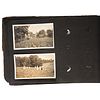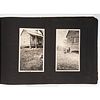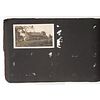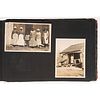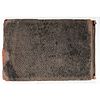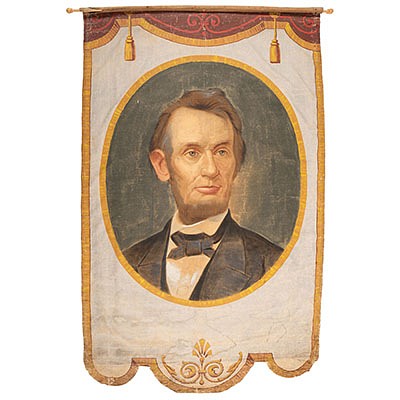[AFRICAN AMERICANA]. Album containing 152 photographs of sharecroppers, cotton plantations, and families at Elgin Plantation. Natchez, Mississippi, 19
About Seller
6270 Este Ave.
Cincinnati , OH 45232
United States
With offices in Cincinnati, Cleveland and Denver, Cowan’s holds over 40 auctions each year, with annual sales exceeding $16M. We reach buyers around the globe, and take pride in our reputation for integrity, customer service and great results. A full-service house, Cowan’s Auctions specializes in Am...Read more
Two ways to bid:
- Leave a max absentee bid and the platform will bid on your behalf up to your maximum bid during the live auction.
- Bid live during the auction and your bids will be submitted real-time to the auctioneer.
Bid Increments
| Price | Bid Increment |
|---|---|
| $0 | $25 |
| $500 | $50 |
| $1,000 | $100 |
| $2,000 | $250 |
| $5,000 | $500 |
| $10,000 | $1,000 |
| $20,000 | $2,500 |
| $50,000 | $5,000 |
| $100,000 | $10,000 |
About Auction
Jun 25, 2021
The June 25 American Historical Ephemera and Photography Auction features an exciting assemblage of 18th-early 20th century material, including Civil War archives, Early Photography, Western Americana, Autographs and Manuscripts, and more. Cowan's Auctions dawnie@cowans.com
- Lot Description
10 1/2 x 7 1/8 in. leatherette album (wear to surface), with 152 images, 3-4 sizes, most 2 7/16 x 4 3/8 in. (some toning/discoloration, occasional chips). Provenance: Thornton A. Green, Elgin, Natchez, Mississippi (gift inscription, affixed to inner rear board).
An album depicting life in Natchez, Mississippi in the early 20th century, from ca 1915-1917. Thornton A. Green, his wife Anna, and son Thornton, Jr. are listed in the 1920 Census living in Elgin near Natchez, Mississippi. Thornton, and his parents, were all born in Michigan and his wife, in-laws, and son were all born in Wisconsin. They are listed in the 1910 Census as living in Ontonagon, Michigan, with Thornton's industry listed as "Lumber," and successful enough to have a live-in Anglo-Irish servant named May Bruneau. They moved to Natchez in 1914, with the Natchez Democrat reporting their arrival on 19 April 1914. They had assumably moved to Mississippi to follow the burgeoning lumber trade. Railroads stimulated the lumber industry in the deep south at the end of the 19th century. In 1880, there were a total of 295 sawmills in Mississippi with an investment of less than 1 million dollars. By 1899, there were 508 mills, with an investment of $10 million, and by 1910, capital investment skyrocketed to more than $39 million. They had taken ownership of Elgin Plantation by 29 December 1914, posting in the Democrat a warning against hunting and trespass. The Greens would become regulars in the society pages, often receiving guests from the upper midwest and visiting themselves. The album itself was a gift from visitors Harry T. Mercer and William K. West who wrote in their gift inscription: "to commemorate a most delightful visit at 'Elgin' in March 1916.
The images include many of Elgin Plantation House, originally built in 1791 it features pillars, a porch, and a second-story balcony surrounded by tall trees with Spanish moss. In addition to family snapshots, the album includes images of the surrounding landscape, livestock and horses, a view of the Mississippi River, as well as architectural remnants from other plantations in the area including Laurel Hill, Monte Bello, and Sligo.
Of particular note are 15 images showing African Americans in Elgin, many showing the humble tenant houses and outbuildings, possible remnants from the era of enslavement. In the 1920 census, several Black families are listed living in Elgin, several of which may be depicted here. Most have their parents' places of birth listed as Mississippi, indicating that most were almost certainly the children of enslaved persons. One image captioned "Tenant's House, Elgin" shows four white adults with a young Black boy standing in front of the meager log structure. Another labeled "Elgin Negross [sic]" shows an African American family of 6 with 2 dogs standing in front of a worn timber house with a raised foundation and small porch. An unlabelled snapshot depicts 9 African American sharecroppers with farming implements in a field. Two snapshots are labeled "Cook & Tuck" with full-length portraits of two Black men in work attire, apparently on the porch and in front of Elgin Plantation, possibly laborers or hired help. An interesting image shows five men, 4 white men with a Black man at center, posing with their kills after a successful bird hunt. A companion image shows a white boy and a Black boy holding their own success from a frog hunt, the white boy holding a gun. A fascinating depiction of life in the Deep South during the era of World War I. - Shipping Info
-
SHIPPING & PICKUPS Cowan’s Cincinnati Office offers an in-house, full-service shipping department which is unparalleled in the auction industry. Shipping costs are provided with your finalized invoice 24-48 hours after auction. For furniture and oversized items, we recommend using third-party services. For more information, contact cowansshipping@hindmanauctions.com. NOTE: All pickups and preview are by appointment only. To make an appointment, please call 513-871-1670 or email cincinnati@hindmanauctions.com Buyers are required to pay for all packing, shipping and insurance charges. Overseas duty charges are the responsibility of the successful Bidder. Be aware that for larger and/or valuable items, shipping charges can be substantial. - Shipping charges include insurance for your order while in transit. If you have private insurance we will adjust your charge to include only packing and shipping. - Please allow 14 – 21 days after payment to package and ship your purchase as carefully as possible.
-
- Buyer's Premium



 EUR
EUR CAD
CAD AUD
AUD GBP
GBP MXN
MXN HKD
HKD CNY
CNY MYR
MYR SEK
SEK SGD
SGD CHF
CHF THB
THB![[AFRICAN AMERICANA]. Album containing 152 photographs of sharecroppers, cotton plantations, and families at Elgin Plantation. Natchez, Mississippi, 19](https://s1.img.bidsquare.com/item/l/8590/8590301.jpeg?t=1LMYow)
![[AFRICAN AMERICANA]. Album containing 152 photographs of sharecroppers, cotton plantations, and families at Elgin Plantation. Natchez, Mississippi, 19](https://s1.img.bidsquare.com/item/s/8590/8590301.jpeg?t=1LMYow)

